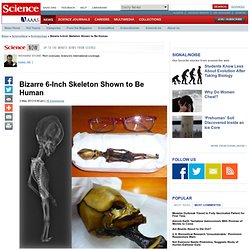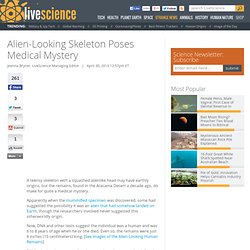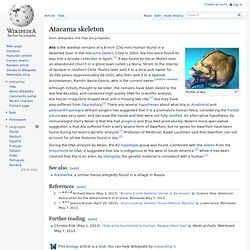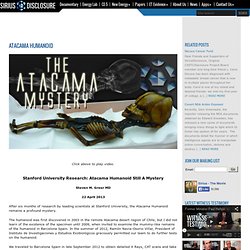

Bizarre 6-Inch Skeleton Shown to Be Human. Alien?

Subhuman primate? Deformed child? Mummified fetus? The Internet is buzzing over the nature of "Ata," a bizarre 6-inch-long skeleton featured in a new documentary on UFOs. A Stanford University scientist who boldly entered the fray has now put to rest doubts about what species Ata belongs to. Figure of Moai Kavakava ancestor. Earth, Intelligent Beings of the Cosmos, and Humanity: Part9: Non-Human Intelligent beings on this Earth in Past and Present, page 1. 9.1.

Alt-week 5.4.13: Atacama's mystery skeleton, move to Mars, and lights out for Herschel. Alt-week takes a look at the best science and alternative tech stories from the last seven days.

Well, here we are. It's happening. We're officially talking about setting up a human colony on Mars. Not only is this very real, it's something you can be part of. You don't have to leave the planet to get your extra-terrestrial fix though, as our two other stories demonstrate. First up is a quick tribute to the Herschel telescope, which slipped out of service this week. What you see above definitely wasn't spotted by the Herschel telescope. Some people will do almost anything to get on TV, even if it means leaving your loved ones behind forever on a one-way trip to Mars.
[Image credits: Mars One, Sirius Movie] The Storm of Disclosure is About to Hit... Alien-Looking Skeleton Poses Medical Mystery. A teensy skeleton with a squashed alienlike head may have earthly origins, but the remains, found in the Atacama Desert a decade ago, do make for quite a medical mystery.

Apparently when the mummified specimen was discovered, some had suggested the possibility it was an alien that had somehow landed on Earth, though the researchers involved never suggested this otherworldly origin. Now, DNA and other tests suggest the individual was a human and was 6 to 8 years of age when he or she died. Even so, the remains were just 6 inches (15 centimeters) long. [See Images of the Alien-Looking Human Remains] Mysterious dwarfish alien brutally murdered in Russia's remote village. Mysterious dwarfish alien brutally murdered in Russia's remote village.

Алешенька 1(гуманоид) UFO Buryatiya.MP4. Unsolved mystery - Kyshtymskiy dwarf / Doc. Movie. DISCLOSURE: Nearly Identical ET Corpses Found in Russia and South America. Kyshtymskiy dwarf. Profession reporter. Is not available. The mummified remains of what looks like a 6-inch space alien has turned "Sirius" into the most eagerly awaited documentary among UFO enthusiasts.

Atacama humanoid. Profile of Ata Ata is the skeletal remains of a 6-inch (150 mm) human found in a deserted town in the Atacama Desert, Chile in 2003.

Ata has since found its way into a private collection in Spain.[1] It was found by Oscar Muñoz near an abandoned church in a ghost town called La Noria, 56 km to the interior of Iquique in northern Chile. Muñoz later sold it to a local pub owner for 30,000 pesos (approximately 60 USD), who then sold it to a Spanish businessman, Ramón Navia-Osorio, who is the current owner.
[citation needed] Although initially thought to be older, the remains have been dated to the last few decades, and contained high quality DNA for scientific analysis. Tiny 'Alien' Skeleton: Tests Reveal 'Atacama Humanoid' From 'Sirius' Documentary Has Human DNA. The 6-inch-long skeleton, nicknamed “Ata,” was discovered in Chile’s Atacama Desert in 2003, and has been a source of intense speculation ever since.

While some have claimed that the odd skeleton was that of a primate or aborted fetus, conspiracy theorists point to its elongated skull as proof that is it actually an alien that crash-landed on Earth. However, researchers at Stanford University have conducted DNA testing that indicates the skeleton has earthly origins. The testers now believe that the tiny humanoid was 6 to 8 years old before it died, Discovery News reports. "While the jury is out regarding the mutations that cause the deformity, and there is a real discrepancy in how we account for the apparent age of the bones … every nucleotide I've been able to look at is human,” Garry Nolan, professor of microbiology and immunology at Stanford School of Medicine, told LiveScience.
Atacama Humanoid. Click above to play video.

Stanford University Research: Atacama Humanoid Still A Mystery Steven M. Greer MD 22 April 2013 After six months of research by leading scientists at Stanford University, the Atacama Humanoid remains a profound mystery. The humanoid was first discovered in 2003 in the remote Atacama desert region of Chile, but I did not learn of the existence of the specimen until 2009, when invited to examine the mummy-like remains of the humanoid in Barcelona Spain. We traveled to Barcelona Spain in late September 2012 to obtain detailed X Rays, CAT scans and take genetic samples for testing at Stanford University. Dr. Dr. We obtained excellent DNA material by surgically dissecting the distal ends of two right anterior ribs on the humanoid. Using forensic documentation procedures, this evidence was then hand-delivered by me to Dr.
Dr. Contact.